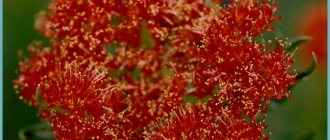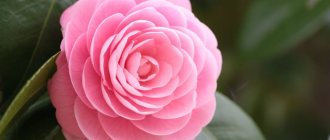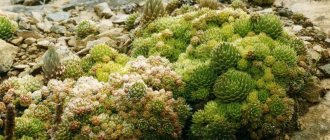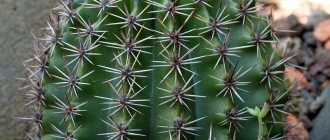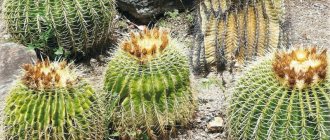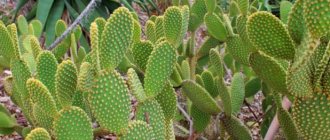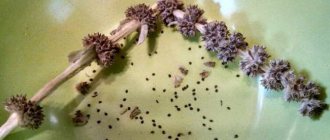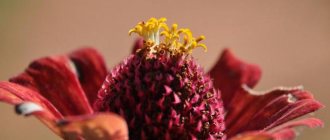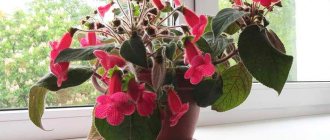Description of the rebutia cactus
The stems of Rebutia are spherical, covered with many prickly needles, and ribbed. Cacti are considered low-growing, as they grow no higher than 6 cm, less often they grow up to 10 cm. The ribs located on the stem are weakly pronounced, arranged in a spiral and separated by tubercles; there are at least 11 ribs on one stem. Due to the fact that the cactus has many spines, it looks like a fluffy ball. The spines can grow from 5 mm to 3 cm. The flowers are large, shiny, wide open, funnel-shaped. Cucumbers come in orange, orange-yellow, red and orange-pink.
Rebutia MINUSCULA - Rebutia is tiny.
Description: Rebutia is a genus of dwarf stem succulents of the Cactaceae family native to the highlands of Argentina and Bolivia. Currently, they grow wild in many dry areas of Africa, America, Asia and Australia.
Small spherical cacti, often flattened on top, grow in meadows among grass or in rock crevices at an altitude of up to 3 km. The plant has a thickened, long rhizome and rounded fleshy stems, on which numerous small papillae are arranged in a spiral. There is a small depression at the top of the spherical stem.
The low ribs are arranged in a spiral shape and consist of small tubercles from which grow thin, short and hard spines, colored silver, whitish or yellowish. An adult specimen produces many children.
The flowers are formed from the lower areoles on the sides or at the base of the stem, and have an elongated tube of fused glossy petals. The diameter of the bell does not exceed 2.5 cm. The petals can be colored red, pink, purple, scarlet, orange, yellow, violet or cream. The core is covered with long yellow stamens. Flowering occurs in April-June. Each flower opens on a sunny day and folds its petals at night. The flowering of one bud lasts about two days.
Rebutia tiny has a spherical light green stem up to 5 cm in diameter, flattened on top. Ribs 16-20. The spines are white, very small, up to 30 radials, the central ones are absent. It easily blooms with large red flowers and produces red balls - berries - without cross-pollination. It blooms in spring and early summer with red flowers up to 4 cm in diameter. A characteristic feature of this species is the imperceptibly bursting of ripe berries, as a result of which small oblong and very tenacious rebutia with microscopic spines appear from the numerous scattered seeds.
Interesting: The genus was described by Carl Schumann in 1895 and named after the famous French winemaker and cactus seller Rebout. However, when a few years later Schumann worked on his monograph on cacti, he demoted the systematic position of Rebutia to the subgenus Echinocactus. Currently, Rebutias are again considered representatives of a full genus, which includes 41 species of small and slow-growing cacti with weak needles.
Care: Representatives of this genus of tiny cacti are unpretentious when grown at home. They bloom beautifully and are easy to cover with a variety of vibrant colors, even for novice gardeners.
Rebutia loves bright lighting with shading from direct sunlight. In the warm season, it is preferable to keep it at high air temperatures. During the rest period, a cool winter in a room with a temperature of 10-15°C is recommended.
Summer watering should be systematic and moderate without drying out the earthen clod. In September-October the plant is not watered at all. In winter, once a month or less is enough. Excess moisture in the soil leads to rotting of the roots. The plant reacts negatively to high dust content; in order to prevent dust from accumulating on the stem, it should be periodically sprayed with clean water.
For cultivation, soil that is well permeable to moisture is used. A suitable substrate can be prepared from a mixture of 2 parts turf, 2 parts humus, 2 parts peat, 1 part leaf soil and 4 parts sand, with half the pot occupied by drainage from broken bricks or shards.
This cactus does not need to be replanted. It can be used to create compositions with succulents. Feeding is carried out once in spring and once in late summer.
Reproduction: Seeds are sown superficially, without being buried in a cactus mixture diluted half with sand, moistened with a spray bottle, covered with film and germinated in the light, but not in the sun at a temperature of 20-25°C. The seedlings need ventilation. It is necessary to avoid waterlogging and drying out of crops.
Caring for rebutia at home
Location and lighting
Rebutia cactus is a light-loving plant. Therefore, it is best to grow it in a well-lit room. Even a place that receives direct sunlight is suitable, since the cactus is not afraid of them, but rather has a positive attitude. But partial shade can affect the growth activity of the cactus.
Temperature
Since Rebutia is a mountain plant that requires very little comfort to grow, caring for it is very simple and requires a lot of effort. The most important rule in caring for a cactus is to give it a rest in a cool place in winter, where the temperature is from 8 to 12 degrees; this allows the cactus to gain strength and delight with abundant flowering in the coming season. Each variety of rebutia requires its own temperature for winter rest, so when purchasing, you need to find out what temperature regime the plant needs.
A mandatory rule for good cactus growth is regular ventilation of the room. Rebutia loves fresh air very much. During active growth, absolutely any temperature is suitable for the plant.
Watering
Rebutia does not require daily soil moisture. The frequency of watering depends on the room temperature and moisture recovery. The main thing is that watering is uniform and sufficient. In summer, the cactus needs to be watered once a week. If the temperature is too high, then watering should be increased to 2 times a week. Since in winter there is much less moisture evaporation than in summer, and the temperature is lower, the cactus needs to be watered less often. When transitioning from winter to summer watering, you need to gradually increase the amount of water.
It is necessary to water the plant exclusively with settled water; its temperature should be a couple of degrees above room temperature. Rebutia needs spraying. To remove dust you need to use a soft brush.
The soil
The soil for planting rebutia should be well permeable and light. It is best to give preference to a ready-made substrate that is specially designed for cacti and succulents. You need to place a small layer of drainage at the bottom of the tails and only then fill it with substrate. There is no need to water the soil before planting; it should be dry.
Feeding and fertilizers
It is not at all necessary to feed the plant. But if you apply special balanced fertilizers intended for cacti and succulents once a month from April to October, the rebutia will thank you with longer and more abundant flowering. You can purchase such fertilizers in absolutely any store for gardeners and flower growers. It should be remembered that fertilizing should only be done in moist soil.
Transfer
The rebutia needs to be replanted only when there is not enough room for it in the previous pot. The most suitable time to transplant a cactus is considered to be the beginning of March. The cactus must be replanted together with a lump of earth. After transplantation, the plant should be placed in a well-lit and warm room. This will allow you to better tolerate the transplant. The first watering after transplantation should be no earlier than a week later. Watering should be moderate for 2-3 months.
Rebutia flowering
The plant blooms only in the second or third year of life. Flowering usually occurs in summer. The flowers bloom during the day and close at night. The rebutia flower lives for at least two days.
It happens that the plant does not bloom, then you need to reconsider the care of the cactus and eliminate all errors. Flowering may not occur due to lack of sunlight. A plant that does not rest in a cool place in winter may also not bloom. The pot where the cactus grows must have a good layer of drainage. Watering should be carried out no more than once a week; in winter it can be stopped altogether.
Rebutia KRAINZIANA 'ALBIFLORA'
Description: Rebutia is a genus of dwarf stem succulents of the Cactaceae family native to the highlands of Argentina and Bolivia. Currently, they grow wild in many dry areas of Africa, America, Asia and Australia.
Small spherical cacti, often flattened on top, grow in meadows among grass or in rock crevices at an altitude of up to 3 km. The plant has a thickened, long rhizome and rounded fleshy stems, on which numerous small papillae are arranged in a spiral. There is a small depression at the top of the spherical stem.
The low ribs are arranged in a spiral shape and consist of small tubercles from which grow thin, short and hard spines, colored silver, whitish or yellowish. An adult specimen produces many children.
The flowers are formed from the lower areoles on the sides or at the base of the stem, and have an elongated tube of fused glossy petals. The diameter of the bell does not exceed 2.5 cm. The petals can be colored red, pink, purple, scarlet, orange, yellow, violet or cream. The core is covered with long yellow stamens. Flowering occurs in April-June. Each flower opens on a sunny day and folds its petals at night. The flowering of one bud lasts about two days.
Rebutia Krajnica white-flowered has thin snow-white spines protruding from the areoles and large white funnel-shaped flowers. Blooms in May-June. An undemanding, very decorative, beautifully blooming species, widespread in indoor culture.
Interesting: The genus was described by Carl Schumann in 1895 and named after the famous French winemaker and cactus seller Rebout. However, when a few years later Schumann worked on his monograph on cacti, he demoted the systematic position of Rebutia to the subgenus Echinocactus. Currently, Rebutias are again considered representatives of a full genus, which includes 41 species of small and slow-growing cacti with weak needles.
Care: Representatives of this genus of tiny cacti are unpretentious when grown at home. They bloom beautifully and are easy to cover with a variety of vibrant colors, even for novice gardeners.
Rebutia loves bright lighting with shading from direct sunlight. In the warm season, it is preferable to keep it at high air temperatures. During the rest period, a cool winter in a room with a temperature of 10-15°C is recommended.
Summer watering should be systematic and moderate without drying out the earthen clod. In September-October the plant is not watered at all. In winter, once a month or less is enough. Excess moisture in the soil leads to rotting of the roots. The plant reacts negatively to high dust content; in order to prevent dust from accumulating on the stem, it should be periodically sprayed with clean water.
For cultivation, soil that is well permeable to moisture is used. A suitable substrate can be prepared from a mixture of 2 parts turf, 2 parts humus, 2 parts peat, 1 part leaf soil and 4 parts sand, with half the pot occupied by drainage from broken bricks or shards.
This cactus does not need to be replanted. It can be used to create compositions with succulents. Feeding is carried out once in spring and once in late summer.
Reproduction: Seeds are sown superficially, without being buried in a cactus mixture diluted half with sand, moistened with a spray bottle, covered with film and germinated in the light, but not in the sun at a temperature of 20-25°C. The seedlings need ventilation. It is necessary to avoid waterlogging and drying out of crops.
Reproduction of Rebutia
Rebutia grows very well and children actively develop around it, so the plant easily propagates vegetatively. For such propagation, it is enough to carefully separate the shoots and dig them into light, loose soil for rooting. Planted children take root very quickly, begin to grow actively, and children will soon form around them.
Rebutia also reproduces by seed, but it will take a little longer. The plant seeds must first be kept in a weak solution of manganese for about ten minutes and then dried thoroughly. Therefore, seeds for seedlings need to be produced in March. The soil is best mixed with sand or stone granules. The distance between the seeds should be at least 3 cm. It is necessary to grow at 15-20 degrees. The substrate should be regularly moistened by spraying from a spray bottle.
When the seedlings grow and become stronger, they need to be planted in separate pots. It was said above that rebutia is very light-loving, so at first the seedlings will have to be additionally illuminated.
Diseases and pests
Sometimes plug formations may appear on the rebuttion. This occurs due to mechanical damage or hypothermia, insufficient watering in the summer. And if you don’t stop watering in winter, the stem may rot. In order to prevent this, watering must be stopped for a while. The root system may rot due to improper dosage of nitrogen-containing fertilizers. If you follow all the rules for caring for the plant, then it will not be afraid of any diseases.
Rebutia is extremely rarely attacked by insects, but such cases still happen sometimes. The cactus can be affected by red spider mites, scale insects and mealybugs. In order to get rid of scale insects and scale insects, you first need to remove adult individuals from the plant with a cotton swab soaked in an alcohol solution, and then thoroughly treat the plant with special insecticides. The same medications can be used for spider mites. For prevention, the rebutia can sometimes be wiped with an alcohol solution.
Types and varieties of rebutia
Below we will describe the more popular types and varieties of rebutia that are grown at home.
Tiny rebutia (Rebutia minuscula), or rebutia minuscula , is a rather miniature plant. It has a spherical shape, the stem is flattened, about 5 cm in diameter. The tubercles are arranged in a spiral. There are quite a lot of spines, all of them are white. The flowers are large, single, bright red or crimson.
Rebutia senilis is a spherical plant that grows up to 8 cm in height and up to 7 cm in width. The spines are white and up to 3 cm in length. The flowers are large, single, very interesting color - the middle is snow-white, and the edges are red.
Rebutia marsoneri is a cactus with very showy flowers. They have a yellow tint and gradually become darker towards the middle. The stems are narrow and fused, spherical in shape. The soft spines are white, while the harder ones are darker.
Rebutia pigmaea is an oval or cylindrical cactus. Strewn with spines, grows up to 7 cm. The flowers are tubular-shaped, red or bright pink.
Rebutia albiflora (Rebutia albiflora) or white-flowered rebutia - this cactus is presented in the form of a group of several small balls strewn with many white needles. The flowers are large and have an interesting color - soft pink at the edges, and gradually turning into a cream shade towards the center.
Rebutia canigueralii - This species is very drought tolerant. The stem is spherical in shape and covered with long and hard needles. The flowers are bell-shaped, the petals are white from the center and pale blue towards the edge, the stamens are bright yellow.
Rebutia fulviseta - spherical stem, dark green. The spines are hard and brown. The flowers can be carrot or bright red.
Rebutia krainziana - the stem is quite large and covered with white tubercles, the needles are short and also white. The flowers are formed in a certain place and have a bright red color.
Rebutia perplexa - the stem is highly branched, covered with small tubercles. The flowers are pink or, less commonly, fuchsia.
Rebutia pulvinosa - the stem is spherical and embossed, covered with a large number of brown spines. The flowers are bright red, red or orange.
Types of cactus with photos
Kara-karskaya
The Rebutium cactus is round, depressed at the top, dark, muted green, ribbed with long gray areoles and yellowish bristle spines.
The size of an individual rebutia cactus does not exceed two and a half centimeters.
The diameter of the striking red-violet funnel flowers is the same.
Goldenspinum
Globular, bright green, up to 7 cm thick . Protected by numerous light yellow sharp spines. Flowering is intense, orange-red.
Tangle-chaete
It usually forms a colony of round, 7 cm, grayish-green plants with a lumpy surface, bristling with transparent whitish spines intertwined with each other.
The funnel cups are bright, golden yellow.
transparent spiny
Green, spherical, eight centimeters, tuberculate-ribbed. Almost completely covered with glassy, prickly “felt” . Funnel flowers are bright red.
Vallegrandskaya
A bright green, rounded, flattened five-centimeter ribbed succulent with whitish pubescent areole buds.
And also has intertwined fine bristles.
In summer, purple-red two-centimeter cups bloom.
Tiny
The tiny rebutia has a flat-spherical shape, up to five centimeters in diameter, light green, with small tubercles arranged in a spiral.
Bristled with small white, yellowish and brown spines. Funnel flowers are three centimeters long, with piercing red petals. The fruits are small and also red.
Dwarf
Elongated, cylindrical, not growing above two and a half centimeters. Dotted with white areoles and small spines-bristles of the same color.
The funnel cups are red and orange; stamens and pistil are yellow .
Albiflora
Two-centimeter succulents with thin, light, dense spines-hairs form branching groups, decorated with white, sometimes with a pinkish tint, funnel-shaped flowers in the summer.
Violet-flowered
Flattened-spherical, up to 7 cm thick, intense dark green color, with long brownish spines. Forms an extensive bush colony . Flowering spring-summer, abundant, pink-violet.
Yellow-flowered
The green, rounded rebutia is dotted with papillae with sparse whitish thin setae and light buds-areoles.
The branching is abundant, the calyxes are orange-yellow, the stamens and pistil are golden.
Krajnica
A spherical, light green, four-centimeter plant with particularly large areoles and short light spines.
The funnel cups are blood-red, also four centimeters long.
Senile
The spherical or slightly elongated green stem does not grow higher than 8 cm . It is densely covered with short, white, translucent bristle spines.
The outer petals are red, the central ones are light. There are varieties with pink and yellowish cups.
Whitest
It is the whitest spines-bristles that dot the flattened spherical five-centimeter succulent.
The funnel corollas are purple, 3 cm in diameter.
This species can withstand temperatures down to -4 ºС .
Sandy
Single five-centimeter succulents, protected by short spines, form 15-centimeter clusters. In spring, the attractive orange-yellow funnel cups open. The cactus is cold-resistant, tolerates negative temperatures - down to minus four .
Narvacensa
Flat-rounded rebutia cacti, 4 cm thick, form colony groups up to 12 cm .
The soft pink three-centimeter funnel-shaped calyxes open in the spring.
This rebutia can withstand temperatures down to minus seven, but is not resistant to rot.
Steinbach
Five-centimeter stems with brown spines and bristles branch profusely. The color of the flowers is very variable: there are varieties with yellow, orange, scarlet, and lilac funnel corollas. Withstands temperatures down to four degrees below zero.
Neokuminga
Single specimens with a diameter of up to 9 cm form groups measuring 25 cm . Numerous yellowish-orange calyxes open into a funnel 2.5 cm across.
This succulent does not survive in freezing temperatures , but is tolerant of intense sun and extreme heat.
Rausha
The dark, gray-green, spherical, slightly tuberculate stem is practically devoid of thorns. Tubular funnels with petals of crimson shades open wide, up to a diameter of 4 cm.
Marsonera
A spherical, light green, finely tuberous rebutia no larger than 5 cm with red-brown spines and bristles blooms in the spring.
The petals are bright, canary yellow; The size of the corolla is about four centimeters.
It does not tolerate prolonged frost of minus 10 ºС.
Mouse
A low succulent with a stem completely covered with whitish intertwined bristles; in summer it is decorated with orange four-centimeter funnel-shaped corollas.
bristly
Ball-shaped six-centimeter; densely braided with a layer of very light bristles-spines.
The inner part of the funnel cups is golden-yellow, the outer part is brownish-purple; this species blooms from May to July.
Helios (solar)
Globular ribbed grayish-green; with age it stretches to a height of up to 8 cm and branches strongly at the base, forming dense, extensive groups.
Short silvery spines-bristles almost completely cover the spiral-ribbed, finely tuberous surface of the stem.
The petals of four-centimeter red-orange funnel flowers unfold in summer and are decorated with a central purple stripe.
Flavistila
A spherical-flattened stem with a diameter of no more than 5 cm, gradually becomes overgrown with a few children.
Numerous flowers of intense red-orange color open up to 4 cm in diameter.
Fulvizeta
Round, slightly elongated stems of a very thick dark green color.
Thickness 5-6 cm and height 8-10 cm.
Densely fused branched groups, covered with gray areoles and protected by brown bristles-spines.
Blooms in mid-summer.
Petals are dark red, shiny, corolla 2.5 cm.
Perplexa
The stem is grayish-green, rounded-elongated, spiral-ribbed, intensively branched, reaching 8 cm in height. The spines are brownish.
Summer flowering, abundant, bright pink-lilac.
In indoor culture it develops well in partial shade .
Pulvinosa
Abundantly branching squat succulent; a single plant is 3 cm thick and 5 cm high. The surface is covered with very light, thin, spine-like hairs. The flowers are orange-yellow, three centimeters
Even in natural conditions, rebutia are characterized by significant species variability.
These unpretentious cacti, flowering and propagating by seeds in indoor culture, as a result of cross-pollination, produce hybrids that are difficult to attribute to a specific species.
Therefore, collectors interested in growing pure forms purchase seeds with a clearly defined species identity and propagate the rebutia grown from them exclusively by lateral shoots.
